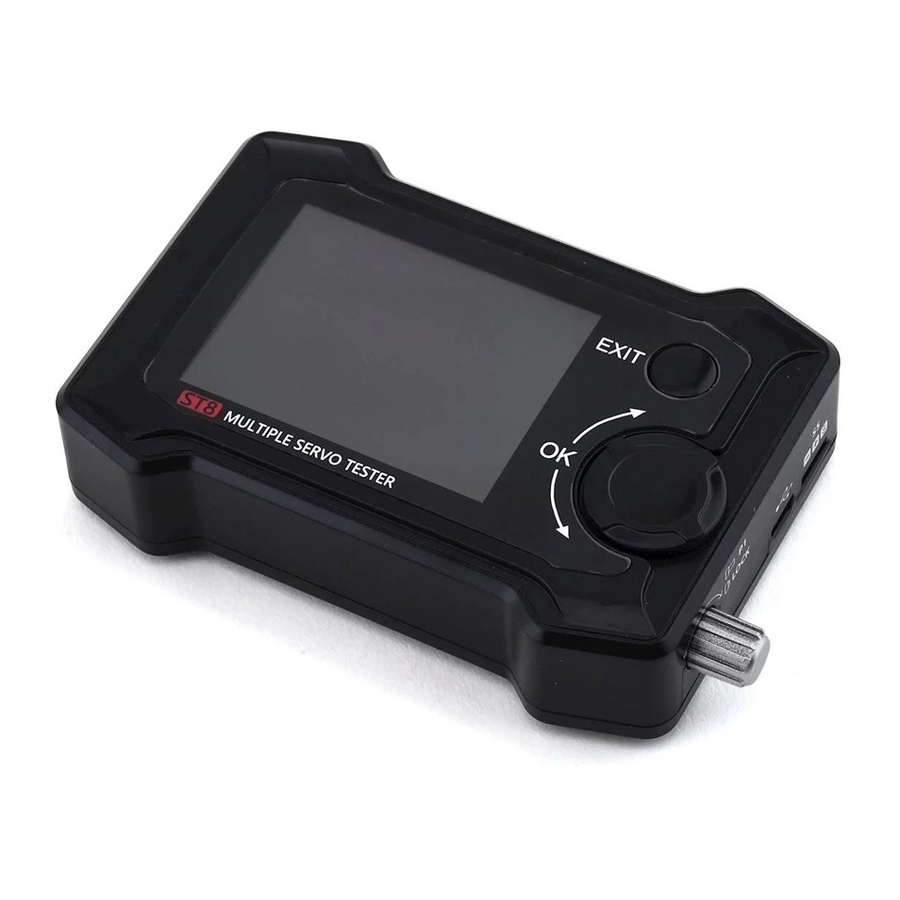
Summary of Contents for ToolKitRC ST8
- Page 1 Manual V1.0 2019.09 www.toolkitrc.com ToolkitRC Technology (Shenzhen) Co.. Ltd. @ToolkitRC 2019...
-
Page 2: Thanks
Thanks Thank you for purchasing the ST8 Multi-function servo tester. Please read this manual carefully before use. Key Points Tips Important Information Further Information To ensure you have a more enjoyable experience, please use WeChat to scan the QR code below and use it to get the usage details, video teaching and latest information. - Page 3 Safety Precautions 1, The ST8 allows input voltage of 7-28V. To ensure that the power supply voltage is consistent, pay attention to the positive and negative polarity of the power supply when connecting. 2, The S1-S4,S4 Ext. signal ports only support a maximum of 2A current.
-
Page 4: Table Of Contents
Pause interface ..........10 Channel setting..........11 1,Signal source setting ....... 11 2,P1 source setting........11 3,S5 source setting ........12 4,Internal source setting......14 5,Key setting ..........16 6,S 1 source setting ........16 7,Output source setting......17 System setting............17 @ToolkitRC 2019... - Page 5 Product overview The ST8 is a product for testing servos, with up to 28V voltage output, 8-channel signal output, current measurement, curve display and other functions. 4 channels of programmable independent signal, 8 channels of signal output, accuracy of 1 ms.
- Page 6 ST8 Layout Display Exit S5 port USB port Knob(OK) P1 knob (press,lock) Front S4 Ext. port Input Output S1-S4 port Back @ToolkitRC 2019...
-
Page 7: First Start
First start 1, the 7-28V power supply is connected to the input port on the back of the ST8 2, the display shows the boot logo and stays for 2 seconds 3, accompanied by do-re-mi boot sound 4, the boot is completed, the display enters the main interface as shown below: 5, Press [Exit] to start the PWM signal output and test. -
Page 8: Main Interface
The output 20.0ms/50Hz is the PWM output frequency and period. Input 9.7V is the input voltage. Below the minimum input voltage set by the system, it will alarm and flash @ToolkitRC 2019... - Page 9 Below is the output bar, which outputs the maximum current, speed, and count of each channel in real time. The PS, PC and PE buttons are in the lower right corner. When the button source mode is selected, the buttons will become selectable. @ToolkitRC 2019...
-
Page 10: Pause Interface
When paused, the current curve is paused and the PWM signal is maintained at a fixed value. Rotate [Knob] to adjust the timeline to view the saved current curve. Press [Exit] to exit the pause interface. @ToolkitRC 2019... -
Page 11: Channel Setting
Channel 1 can be set to P1, S5, internal signal, button, and 4 sources. Channels 2-4 can be set to P1, S5, internal signals, buttons, channels 1, and 5 sources. After selecting the appropriate source. Short press [OK] and [Exit] to take effect. 2,P1 source setting @ToolkitRC 2019... -
Page 12: 3,S5 Source Setting
PPM, and SBUS signals can be selected. By inputting the corresponding signal on the S5 interface, the received signal value can be displayed and the PWM output can be controlled. When the PWM signal is selected, as shown below: @ToolkitRC 2019... - Page 13 When the PPM signal is selected, the channel can be set from CH0 to CH7, as shown below: When the SBUS signal is selected, the channel can be set from CH0 to CH15. As showed below: @ToolkitRC 2019...
-
Page 14: 4,Internal Source Setting
1 microsecond to 10 microseconds, and the speed value ranges from 1 millisecond to 10 milliseconds. Taking 1 respectively means adding 1 microsecond or 1 microsecond each time in the range of the PWM signal output at a speed of 1 ms. As showed below: @ToolkitRC 2019... - Page 15 PC point is enabled, it is the third-order mode, which jumps between the three values of PS, PC and PE at 1 second. This mode allows you to measure the response speed of the steering gear. As shown below: @ToolkitRC 2019...
-
Page 16: 5,Key Setting
The time to turn the angle can be measured and displayed. As shown below: 6,S1 source setting When S2, S3, S4 signal source selects S1, it will follow the S1 setting and output S1 with the same PWM value.As shown below: @ToolkitRC 2019... -
Page 17: 7,Output Source Setting
PWM output signal with an accuracy of 1 microsecond. If you are in the button source and internal source stage modes, you need to set the PC value. System setting Press [OK] on the main interface for 2 seconds to @ToolkitRC 2019... - Page 18 CycleCount: When using the internal signal source, a count will be generated, and when the set number of work times is reached, the operation will stop. LowestInput: Below this voltage, the device will stop the @ToolkitRC 2019...
- Page 19 It is divided into bright and dark colors. KNOB Calibration: Jump the P1 knob to the calibration of the maximum and minimum implementation knobs. CycleCountClear: Clear the count under the internal source. Default : Restore all settings to factory defaults. Other functions Firmware upgrade: @ToolkitRC 2019...
- Page 20 After connecting the ST8 to the computer via the USB cable in the box. the computer will recognize the USB flash drive named Toolkit. Download the upgrade file app.upg on the official website to overwrite the files in the USB flash drive to upgrade the firmware.




Need help?
Do you have a question about the ST8 and is the answer not in the manual?
Questions and answers